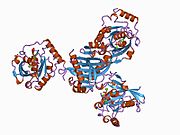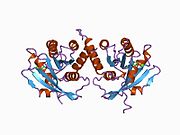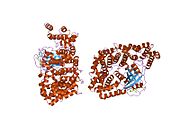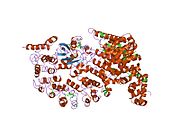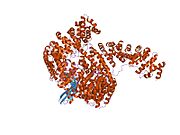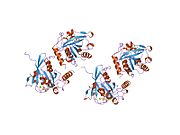Ran (protein)
Ensembl | |||||||||
|---|---|---|---|---|---|---|---|---|---|
| UniProt | |||||||||
| RefSeq (mRNA) | |||||||||
| RefSeq (protein) | |||||||||
| Location (UCSC) | Chr 12: 130.87 – 130.88 Mb | Chr 5: 129.1 – 129.1 Mb | |||||||
| PubMed search | [3] | [4] | |||||||
| View/Edit Human | View/Edit Mouse |
Ran (RAs-related Nuclear protein) also known as GTP-binding nuclear protein Ran is a protein that in humans is encoded by the RAN gene. Ran is a small 25 kDa protein that is involved in transport into and out of the cell nucleus during interphase and also involved in mitosis. It is a member of the Ras superfamily.[5][6][7]
Ran is a
Function
Ran cycle

Ran exists in the cell in two nucleotide-bound forms:
Ran can diffuse freely within the cell, but because RCC1 and RanGAP are located in different places in the cell, the concentration of RanGTP and RanGDP differs locally as well, creating concentration gradients that act as signals for other cellular processes. RCC1 is bound to
Role in nuclear transport during interphase

Ran is involved in the transport of proteins across the nuclear envelope by interacting with
Role in mitosis
During mitosis, the Ran cycle is involved in
Ran and the androgen receptor
RAN is an androgen receptor (AR) coactivator (ARA24) that binds differentially with different lengths of polyglutamine within the androgen receptor. Polyglutamine repeat expansion in the AR is linked to spinal and bulbar muscular atrophy (Kennedy's disease). RAN coactivation of the AR diminishes with polyglutamine expansion within the AR, and this weak coactivation may lead to partial androgen insensitivity during the development of spinal and bulbar muscular atrophy.[12][13]
Interactions
Ran has been shown to
Regulation
The expression of Ran is
See also
References
- ^ a b c GRCh38: Ensembl release 89: ENSG00000132341 – Ensembl, May 2017
- ^ a b c GRCm38: Ensembl release 89: ENSMUSG00000029430 – Ensembl, May 2017
- ^ "Human PubMed Reference:". National Center for Biotechnology Information, U.S. National Library of Medicine.
- ^ "Mouse PubMed Reference:". National Center for Biotechnology Information, U.S. National Library of Medicine.
- PMID 7519373.
- PMID 8923203.
- PMID 9683621.
- PMID 10704362.
- PMID 15452138.
- S2CID 8687055.
- S2CID 4417176.
- PMID 10400640.
- PMID 11501969.
- ^ PMID 10779340.
- PMID 9135132.
- PMID 9102465.
- PMID 12101123.
- PMID 15522285.
- PMID 9533885.
- ^ PMID 10811801.
- ^ PMID 7891706.
- PMID 10394366.
- PMID 7744835.
- PMID 8146159.
- S2CID 12827419.
- PMID 10369786.
- S2CID 4413233.
- ^ PMID 12384575.
- PMID 12070164.
- S2CID 15119502.
- PMID 11777942.
- PMID 18498749.
External links
- ran+GTP-Binding+Protein at the U.S. National Library of Medicine Medical Subject Headings (MeSH)
- Patel SS. "Animations of nuclear transport factors, including Ran (1 of 2 pages)". Nuclear Transport Animations. Archived from the original on 2009-02-07. Retrieved 2008-06-12.
- Patel SS. "Animations of nuclear transport factors, including Ran (2 of 2 pages)". Nuclear Transport Animations. Archived from the original on 2009-02-07. Retrieved 2008-06-12.

